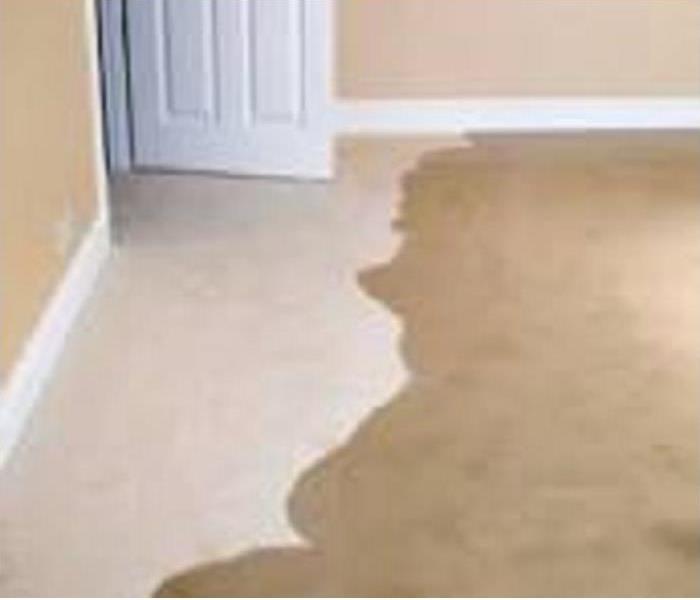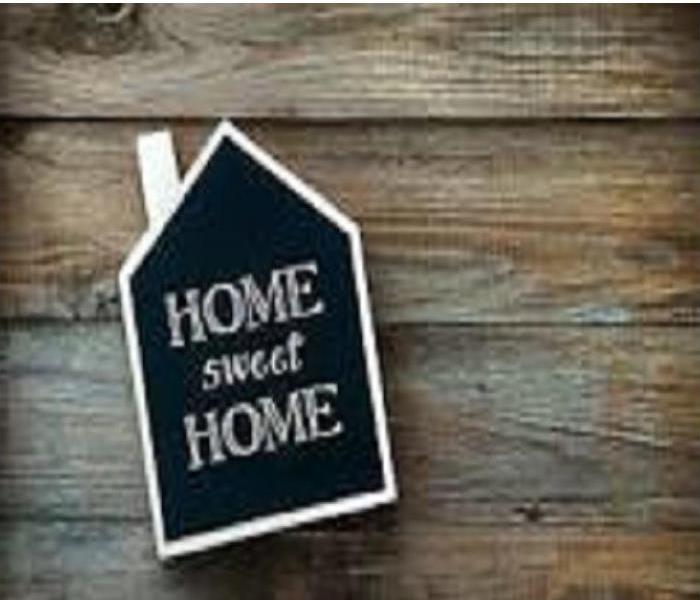Recent Water Damage Posts
5 Things Every Business Owner Should Know About Water Damage
9/5/2023 (Permalink)
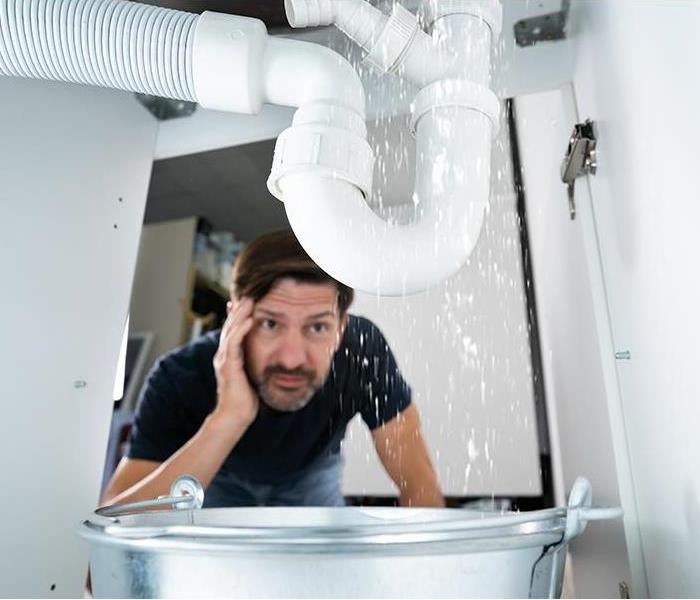 water leaking
water leaking
Leaking valves and appliances. Bursting pipes from frigid winter weather conditions. Plumbing problems…regardless of the cause, water damage can be a costly issue for your business.
Insurance claims statistics reveal that frozen, bursting pipes affect about 15% of small businesses. Water damage can wreak havoc on your carpets, inventory, and equipment. Water damage can also cause structural damage and mold growth. In more extreme instances, it can force you to relocate or close your business temporarily.
What can a business owner like you do to avoid a damaging water situation? Follow these 5 tips:
- Know where your main shut-off valve is. There is no time to waste if a water pipe breaks in your business. Make sure you know where the main water valve is located so you can get to it immediately. This will stop water from flowing to the building and prevent flooding until you can fix the problem.
- Keep the heat on inside your buildings and structures. Your thermostats should never be set below 50 degrees Fahrenheit, even when your business is closed or vacant. Keep batteries in your thermostats so they’re working properly, and make sure you keep the heat on sufficiently to prevent any pipes from freezing and bursting.
- Insulate and seal exterior building cracks or gaps. Your ultimate goal is to keep cold air from seeping into your building, especially in the dead of winter. Even a small crack or gap that’s not sealed can cause your water pipes to freeze. Use caulk, weather stripping, spray foam or other sealants to make your building more energy efficient and keep the cold air out.
- Wrap or insulate exposed pipes. Any exposed pipes can increase the risk of freezing, especially during some of our winter nights in Wisconsin. When water freezes in a pipe that’s not properly insulated, it expands and creates pressure which can cause the pipe to burst. Bursting pipes can lead to expensive structural damage or flooding. You can minimize your risk by wrapping the pipes with inexpensive foam insulation that's available at most hardware stores.
- Keep your HVAC and sprinkler systems in proper working order. Regular inspections of your HVAC, plumbing, and sprinkler systems are important in preventing an expensive loss or cleanup. In fact, these malfunctioning systems are the leading cause of property loss in commercial buildings.
If Water Damage Happens…
Hopefully these tips will help prevent costly issues in your business. But should you experience water damage, SERVPRO of Southeast Milwaukee County, Southeast Waukesha County is here for you 24/7—simply call 414-421-3500. Our water damage restoration experts are your best resource in an emergency. We have the proper equipment and training to extract water properly and return your business to the condition it was in before water damaged happened. We also have the tools to detect any residual water that may be trapped behind walls or in tight spaces, so you don’t have to deal with water damage and mold growth problems for years to come.
6 Steps After Water Damages your Home
1/17/2022 (Permalink)
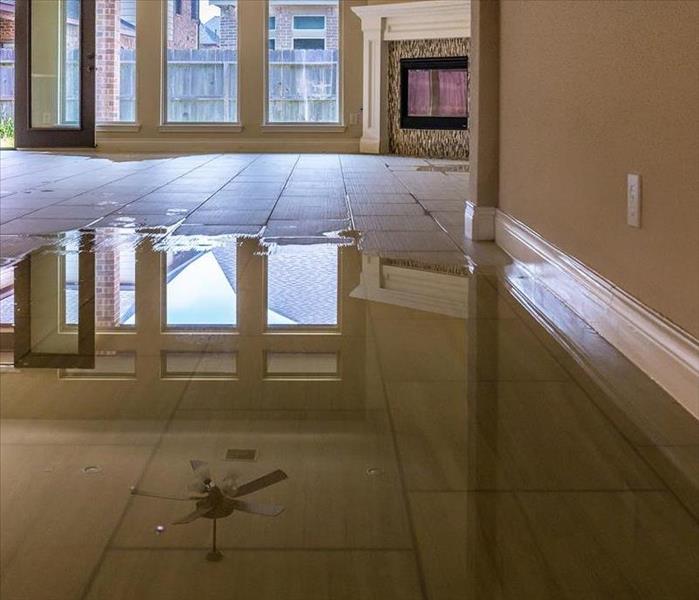 Water Damage
Water Damage
Take These 6 Steps After Water Damages Your Home
When severe water damage or flooding happens in your home, it’s nothing shy of devastating. Water damage can be caused by several factors, such as malfunctioning appliances, frozen and bursting pipes , a torrential rainstorm, sewer backup, or a flooded basement. No matter the cause, these six steps will help maximize your safety and minimize the damage to your home and surrounding property.
Step 1: Your Safety Always Come First!
Making sure you and your loved ones are out of harm’s way is your top priority after flooding or other water damage situations in your home. This means turning off the power in your home since water and electricity are a dangerous mix; turning off the main water valve in your home; and wearing protective gear like rubber gloves and boots to prevent the spread of any bacteria in standing water.
Step 2: Document Damage, Then Call Your Insurance Company and a Water Damage Restoration Professional.
Take record of every item in your home and take as many photos as possible to document the damage. Then call your insurance company to report the damage and schedule an appointment with a claims adjuster who can assess the situation and see what’s covered under your homeowner’s policy. Since water damage can have immediate affects, it’s also important to call a water damage restoration professional like our SERVPRO team as soon as possible so we can assess the damage and begin the restoration process. We’re available 24/7 for any size disaster at 414-421-3500.
Step 3: Protect Your Home’s Valuables.
Assess the damage and determine what valuables you can safely salvage. Depending on the extent of water damage, it’s best to leave the water removal process to a trained specialist. They have the equipment and skills necessary to properly remove water, sanitize areas, and dry out items in your home. But if you opt to start the process yourself, make sure you’re wearing protective gear and remove items with severe damage, such as water-soaked rugs. Also, preserve what valuables you can that have not been impacted by water damage, such as furniture.
Step 4: Dry Out Your Home and Identify Mold.
If you choose to start drying your home out on your own, make sure it is safe and you wear the proper protective gear, then use a wet vacuum and fans to remove water and dry areas. Also, carefully inspect water-soaked areas for mold. Note that mold can grow in as little as 48 hours following water damage if there is enough moisture. At SERVPRO, our water removal pros use industrial-grade dehumidifiers help prevent secondary water damage like swelling and warping of floors, walls, and furniture. We also use high-speed air movers create airflow across walls, carpets, pads, and furniture, which accelerates the evaporation of moisture.
Step 5: Determine What Items Can be Restored, Cleaned and Repaired After Water Damage.
Some items will be easy to identify, clean and restore, but others may have more extensive damage. But there may be other areas in your home that require more extensive repairs, such as replacing drywall and flooring. In this case, you may need to work with your water damage restoration team to determine what construction professionals will help get your home back to its “Like it never even happened,” condition.
Step 6: Move Back Into Your Home.
When you can move back into your home depends on the extent of the water damage. If it’s just one room that was impacted, you can likely stay in your home the entire time but it may take at least 72 hours to several weeks before the repairs are complete and the damage is completely restored. Extensive water damage may mean that your home is not livable again in certain areas for several weeks or months. That’s why it’s best to get your insurance company and a water damage restoration provider involved as soon as possible so you can ensure proper repairs are being scheduled and made.
For Cleaning and Repair Beyond Water Damage
From fire damage and mold remediation to cleaning and sanitization, there are many other home emergencies that require professional help. Luckily your SERVPRO of Southeast Milwaukee County Team is only a phone call away at (414) 421-3500. Any time or day, we’re here to clean and restore homes and businesses.
My Appliance is Leaking! Take These Immediate Steps
1/7/2022 (Permalink)
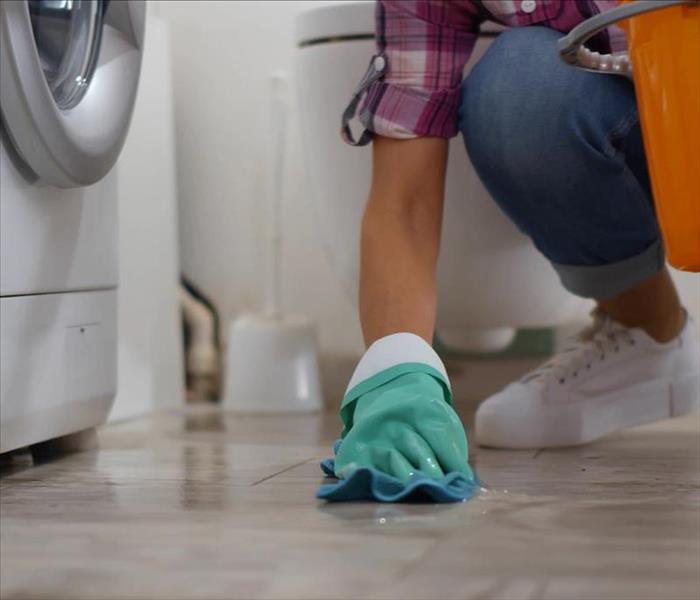 Leaking Appliance
Leaking Appliance
You wake up, stumble in the kitchen to make your coffee, and see it…Water pooling under your sink. Panic sets in. Few people think about what to do immediately after an appliance is leaking. That’s why the experts at SERVPRO of Southeast Milwaukee County share these steps you can take as soon as you spot the leak.
- Shut off the water source for that appliance.
The sooner you stop the water, the better in terms of damage and repair costs. Most times you’ll find the main water shut-off valves in your basement.
- Determine where the water is coming from.
There are typically three main sources for most water leakage problems: a drain line, a supply line, or a burst pipe. Leaks in drain lines happen when a drain isn’t properly working. Whether a drain leak is fast or slow, it can cause bacteria to grow in the line. A leak in your supply line is coming from that pipe that brings water to your appliance. When you spot a burst pipe, the best thing to do is put a bucket underneath it to catch any leaking water.
- Unplug any electronics near the leaking appliance.
As you know, water and electricity are a dangerous mix. Be sure to shut off and unplug any electronics near the leak. Your safety is paramount: If the leak seems excessive, turn off your home’s circuit breaker, and call your local electrician, as well as the water damage restoration professionals to assess the situation and return your home back to normal.
- Take photos for your home insurance claims.
It’s important to take photos of the leak and the subsequent water damage for insurance purposes, especially if the damage is extensive. Do this before cleaning up any of the mess so that you have accurate documentation of the leak and the property damage.
- Call the professionals to repair the water leak and damage.
You can attempt to identify the water leak type and resolve it yourself, but that may not be the best long-term solution. A wiser investment is to call the local plumbing professional who can fix your leak and appliance properly. If there is damage as a result of the leak, it’s also best to contact your local restoration company, too.
When Leaks Happen, Call SERVPRO 24/7
Don’t deal with the aftermath of water damage from a leaking appliance alone—trust a team of technicians who are equipped to help you around the clock, even on holidays. That team is your trusted neighborhood SERVPRO of Southeast Milwaukee County. Fellow residents and businesses also rely on us beyond water damage restoration—we do everything form air duct cleaning and disinfecting to storm damage and mold remediation. Call 414-421-3500, or contact us online.
Your Peace of Mind
1/6/2022 (Permalink)
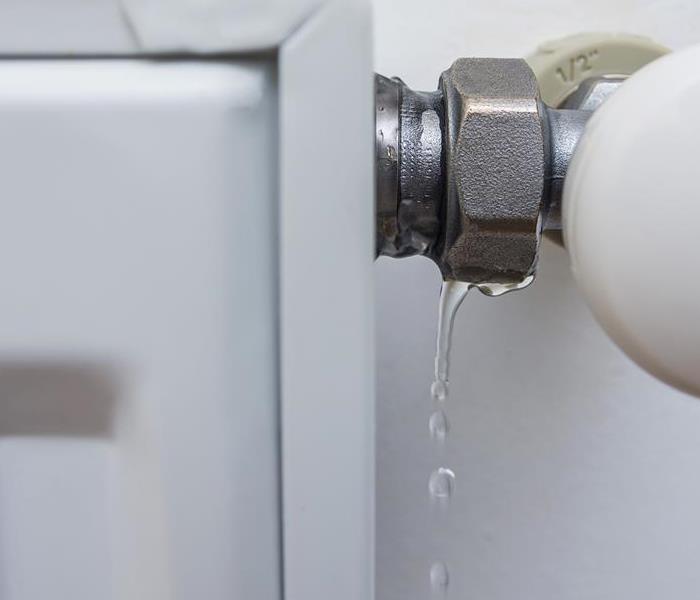 water loss
water loss
Leaks within a home or business can cause extensive damage if unnoticed for a long period of time. Leaking water can seep into flooring, carpets, baseboards and walls while moving throughout the structure. Such a leak not only damages your property, it can also interrupt you day-to-day schedule.
One out of every ten water incidents in a home is caused by a water heater or washing machine. When you find a leak, you can also find the damage it causes to your home.
It's natural to feel a sense of panic. SERVPRO of Southeast Milwaukee County can provide peace of mind. We understand your concerns and are trained in the cleanup and care of your home and property. Our professional technicians utilize the knowledge and experience only gained by doing hundreds of jobs similar to yours and are prepared to properly clean up damage caused by a leaking water heater or washing machine.
SERVPRO of Southeast Milwaukee County is ready to help make it "Like it never even happened."
Should you clean it up yourself?
1/5/2022 (Permalink)
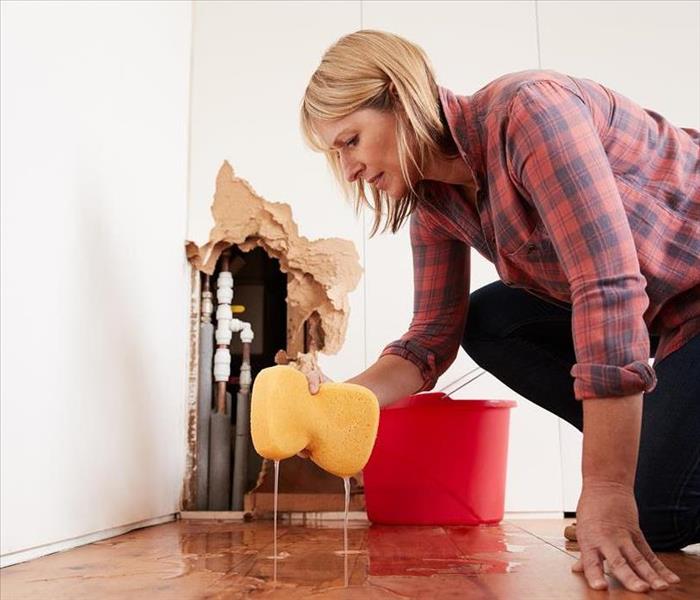 Cleaning up water alone
Cleaning up water alone
There's no such thing as a small disaster. Especially when the water you don't see contains bacteria - or causes mold, rot and other unseen damage. Water damage can affect the value of your property. So before you get out the mop bucket and box fan to try and clean it up yourself, consider how this will affect your property.
A mop and common cleaning products may not be enough for serious water intrusions.
SERVPRO of Southeast Milwaukee County is equipped to safely clean and restore your home or business, utilizing the following procedures:
- Identify the Source/Type of Water
- Measure Temperature and Humidity for drying analysis.
- Survey the extent of damage and inspect the premises.
- Perform emergency water extraction
- Apply necessary treatments i.e. disinfectants/deodorization.
- Utilize drying equipment and monitor drying.
So, before you risk further damaging the value of your home or business by attempting to clean up the mess yourself, call SERVPRO of Southeast Milwaukee County at 414-421-3500.
"Like it never even happened."
A small water leak, may not be small...
1/4/2022 (Permalink)
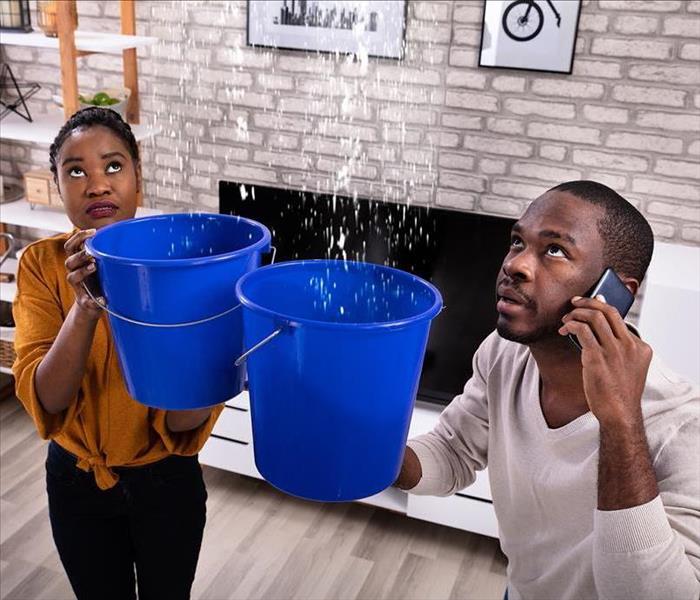 water damage
water damage
SERVPRO of Southeast Milwaukee County has crews that are professionally trained to safely clean and restore your home, utilizing the following procedures:
- Identify the Source/Type of Water
- Measure Temperature and Humidity for Drying Analysis.
- Survey the Extent of Damage and Inspect the Premises for Hidden Moisture.
- Perform emergency water extraction.
- Move and block furniture and contents
- Inspect Carpet Pad / Carpet and provide service.
- Apply necessary treatments (disinfectants/deodorization)
- Utilize advanced drying and monitoring equipment.
- Dispose of refuse
Areas that can be affected by a small water leak and you don't even realize it are:
- Break exterior
- Sheathing
- Wall Studs
- Insulation
- Interior area
- Drywall
- Baseboard
- Carpet
- Carpet Padding
- Bottom wall plate
- Sub-floor
- Floor joist
- sill Plate
- Basement
- Foundation
If you notice water, give us a call at 414.421.3500. SERVPRO of Southeast Milwaukee County will be out to help!
SERVPRO "Like it never even happened."
My dishwasher leaked all over my hardwood floors
1/4/2022 (Permalink)
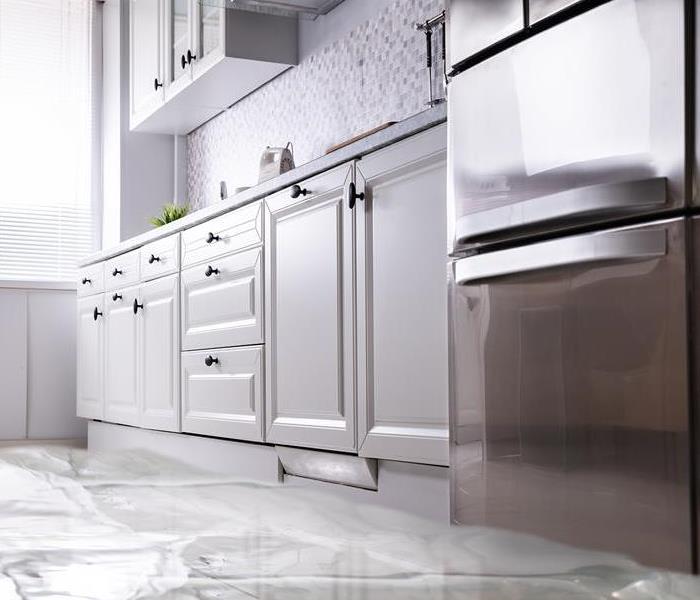 kitchen water damage
kitchen water damage
It happens. Your dishwasher leaks all over your beautiful hardwood floors and not they are starting to cup. The first thought is that you will need to pull them up and replace them - not necessarily.
Give SERVPRO of Southeast Milwaukee County a call - we have had great success in drawing out the moisture in hardwood floors allowing them to be sanded and refinished Much more economical over replacement.
How do we do this? We use our Injectidry Mat System that uses the power of a high-pressure blower to draw the moisture right through the surface of the floor. We create containment and pump dehumidified air into the containment. It takes between 5-10 days to accomplish dependent on how long the wood was saturated before we began, but the results are amazing.
So, before you start ripping out that beautiful hardwood, give us a call!
SERVPRO of Southeast Milwaukee County "Like it never even happened."
How to Avoid Water Damage in Your Home This Winter
12/28/2021 (Permalink)
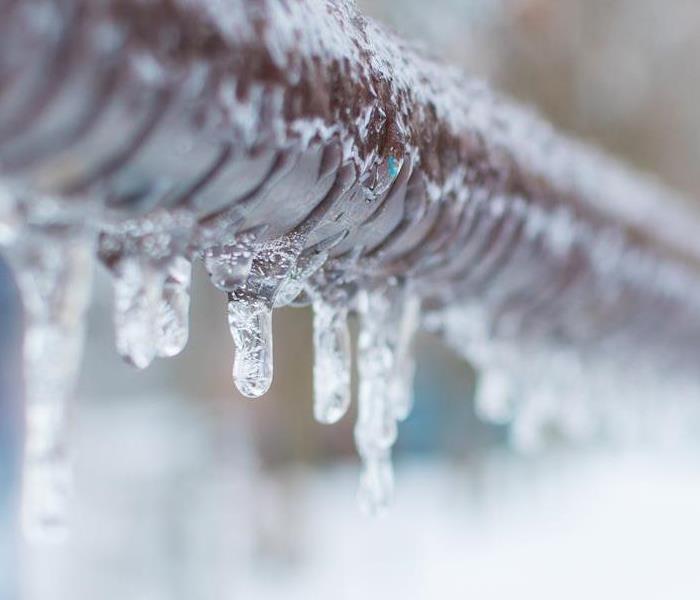 Winter Water Damage
Winter Water Damage
Winter months in Wisconsin can be wicked. Snowstorms, icy conditions, and temperatures well below zero can all contribute to water damage in your home. Fortunately, there are some ways you can protect your property and hopefully prevent a water damage situation.
Know where your home’s water main is located.
Ask any plumbing professional what the most important plumbing feature is in your home—they’ll all agree it’s your water main valve. This water main valve supplies water to your entire home as it’s distributed to other pipes. Should your pipes freeze or any water-dependent appliances malfunction (i.e., washing machines, dishwashers), you need to know where this water main is so you can shut all your home’s water off immediately.
Keep pipes from freezing.
Make sure any exposed pipes in your home are well insulated—pick up pipe sleeves from your local hardware store. When frigid temps are in the forecast, make sure you leave the cabinet doors open under all of your sinks so warm air can circulate to keep your pipes from freezing. While you’re away on vacation during winter months, keep your thermostat set so your heat stays on at a low but warm enough temperature to keep indoor pipes from freezing.
Remove ice and snow from problem areas surrounding your home.
If not properly removed, accumulating snow and ice can cause water damage to your home. A common example of this is on rooftops. Over time, the snow can create an edge on your roof that prevents melting snow from draining properly and causes roof leakage. Basement windows are another area where snow and ice should be removed, as leaks can happen easily, especially if there are any cracks in your foundation. If melting snow gets into the cracks in your foundation and freezes, that freezing causes expansion. This expansion can lead to some major damage to your home’s foundation and inside areas.
When Water Damage Hits Your Home…
If you experience water damage this winter or any other time of the year, it’s important to act immediately—the longer water sits in your home, the more damage it causes. Our water damage restoration specialists at SERVPRO of Southeastern Milwaukee County are standing by to help you 24/7. They’ll quickly assess the damage, then use the latest technology to monitor and dry the affected area while simultaneously dehumidifying the surrounding space. Call us at (414) 421-3500.
Why Has My Sump Pump Failed and What Can I Do About It?
11/24/2020 (Permalink)
 Logo shot with aerial view background
Logo shot with aerial view background
It’s a sight a homeowner never wants to experience: a basement floor covered in several inches of water and the eerie silence of an idle sump pump. A failing sump pump is a wet and often expensive mess. But these telltale signs can help you prevent flooding and preserve your property.
How a Sump Pump Works
A sump pump is a pump that’s installed in the lowest part of a basement or crawlspace. As its name implies, a sump pump’s job is to pump water in order to help the area under the building stay dry and prevent it from flooding. Most sump pumps are installed in specially constructed pits. When water collects in these pits, it’s pumped out and away from the building.
Given this important “stay-dry” job, it’s obvious that a failing sump pump often leads to a flooded basement and expensive water damage. Unfortunately, even less than an inch of standing water on your basement floor can quickly transform into property damage and a mold problem.
Know the Signs, Spare Your Property
The SERVPRO of Southeast Milwaukee County staff shares their tips about what causes sump pump failure and what you can do to prevent or minimize water damage:
- The sump pump switch is stuck in place. A stuck switch is one of the most common reasons why a sump pump fails. There are several different types of sump float switches—vertical and tethered floats are most common. Vertical floats are often more reliable, as tethered floats have a habit of getting stuck on the side walls of the sump pit. Debris in the pit is the main reason why floats get stuck. You can check the float by shutting the sump pump’s power OFF and removing any debris in the pit.
- The power is out. Just like a dishwasher or washing machine, if your sump pump has no power source, it’s not going to work. In the case of a severe storm, a power outage can lead to a flooded basement quickly. That’s why it may be wise to invest in a high quality battery back-up sump pump. When charged properly, this battery backup system operates a separate pump linked to the discharge pipe for hours of protection until your power is restored. Some backup pumps even monitor the battery’s condition and alert you when it needs to be replaced.
- Your sump pump is not the right size. Much like a water heater, there are different sum pumps for different performance demands. It’s best to consult with a plumbing professional to make sure your sump pump is the proper horsepower to keep up with your home’s or business’ flow of water.
- Your sump pump is aging and needs replacement. Sump pumps are not built to last forever. In fact, it’s recommended that sump pumps are replaced every five to seven years to ensure they’re operating effectively and keeping your property dry.
- The discharge pipe is frozen. Frozen pipes throughout homes are a particular concern given our harsh Wisconsin winters. With regards to a sump pump, the discharge pipe is an issue if it’s not installed and pitched properly. This then causes water to collect, freeze, and eventually block it from flowing.
From Sump Pumps to Storm Damage, Rely on Our Expertise
Basement flooding from sump pump failure is serious—that’s why your local SERVPRO experts are here when you need us. Call us 24/7 at 414-421-3500. Or depend on us for other repair, restoration, and cleaning services for your home or business.
How to Prevent Frozen Pipes and Property Damage
11/24/2020 (Permalink)
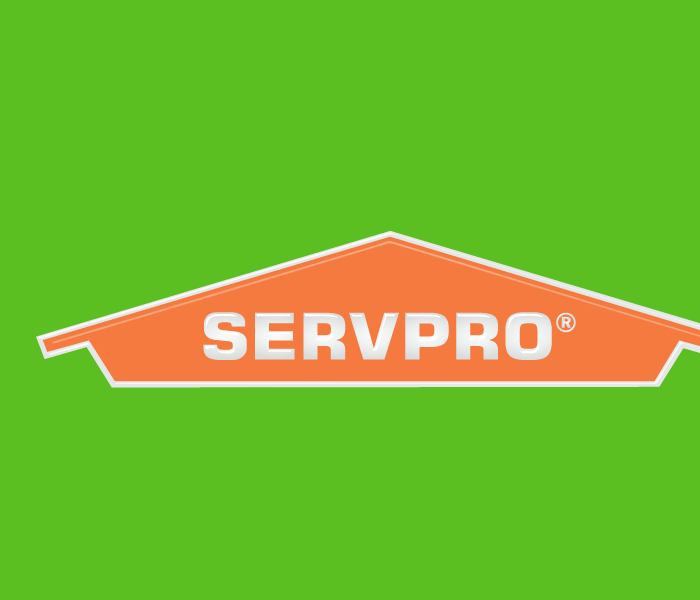 SERVPRO logo on green background
SERVPRO logo on green background
One thing you can count on every year in Wisconsin? Frigid winter weather in some form or another. That’s why it helps to have these tips handy to prevent frozen pipes in your home or business when outdoor temps plummet:
- When you know below-freezing temperatures are forecasted, allow water to run in all the sinks at a slow, constant drip. Just a trickle is enough to keep the water moving through the pipes and prevent them from freezing.
- Open up the cabinet doors in your bathroom vanities and under your kitchen sink. This allows heat from the home to circulate and keep the pipes warm.
- Keep your house at a warm, consistent temperature during the day and night.
- If you leave home for extended periods of time, keep your thermostat to at least 55 degrees Fahrenheit.
- To keep garage pipes from freezing, make sure your garage door stays closed.
- If your pipes do freeze, use a hair dryer, heat lamp, or heat gun to thaw them. Then run hot water from your faucet for a couple minutes to keep the pipes warm.
Frozen Pipe Damage? Call SERVPRO Immediately.
When pipes freeze in your home or business, it could lead to a burst pipe and eventual water damage. Trust your local SERVPRO staff here in Southeast Milwaukee County to help get your home or business back to normal. Contact us anytime at 414.421.3500 for help in an emergency, or to learn about our other repair, restoration, and cleaning services.
Why Call a Professional for Water Damage?
11/19/2020 (Permalink)
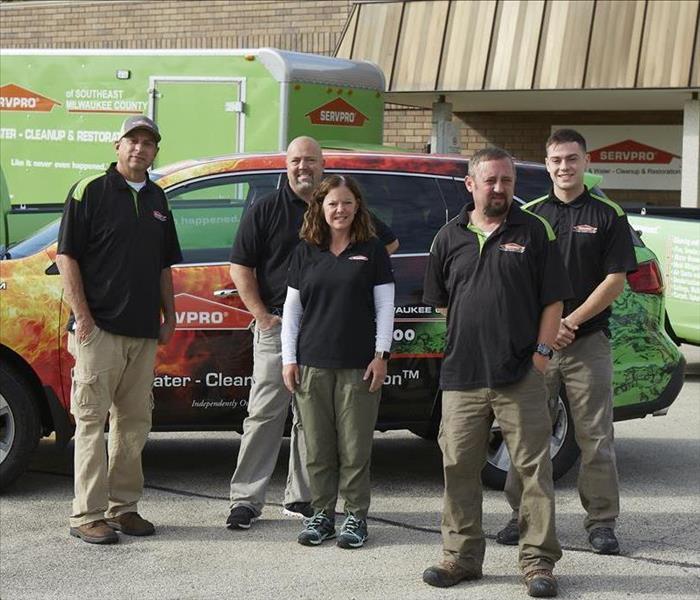 SERVPRO team portrait in front of building
SERVPRO team portrait in front of building
Water damage. These two words can carry some serious consequences in terms of health issues and property destruction. That’s because depending on the situation, the extent of water damage can be hard to identify in your home or business. The best way to get answers and save your property or building’s integrity from future damage is to consult a professional.
Suspecting Water Damage in Your Residential or Commercial Property
Has a water stain appeared on your ceiling? Or have you noticed another sign that you think may indicate water damage? Before you call a professional, it’s a good idea to investigate the suspected water damage on your own. In fact, get in the habit of inspecting your home carefully every few months for signs of water damage—flaking or peeling paint; water stains on the walls or ceiling; puddles or moist spots on floors or under sinks/vanities; and bowed walls. Mold or dried water stain spots are also telltale signs that water damage is or was present and may not have been correctly addressed. The more you see these signs typically means the more severe the damage.
After taking note of any and all signs of suspected water damage, it’s time to call a professional to assess what you’ve noticed as well as pick up on any others that you may have missed. Better to be safe than sorry when it comes to water damage—calling a professional is a wise choice.
When Water Damage is Evident
Are there obvious signs of water damage on your property? This could include big stains in the ceiling or walls; mold growth along walls, in basements, or under sink/vanity areas; or compromised structural integrity. When water damage is evident, you should call a professional as soon as possible to survey the damage and advise you on next steps. In some cases if the water damage is extensive enough, it may not be safe for you to remain in the building.
Restore Your Property from Water Damage and So Much More
Whether it’s subtle or obvious, water damage can have a lasting negative impact on your residential or commercial property. But with our knowledge, equipment and experience, we can help bring the value back to your property—contact SERVPRO of Southeast Milwaukee County at 414.421.3500 around the clock, every day. Or rely on us for other cleaning and restoration services, such as storm damage, fire restoration, and mold remediation.
What to Do After Your Basement Floods
11/19/2020 (Permalink)
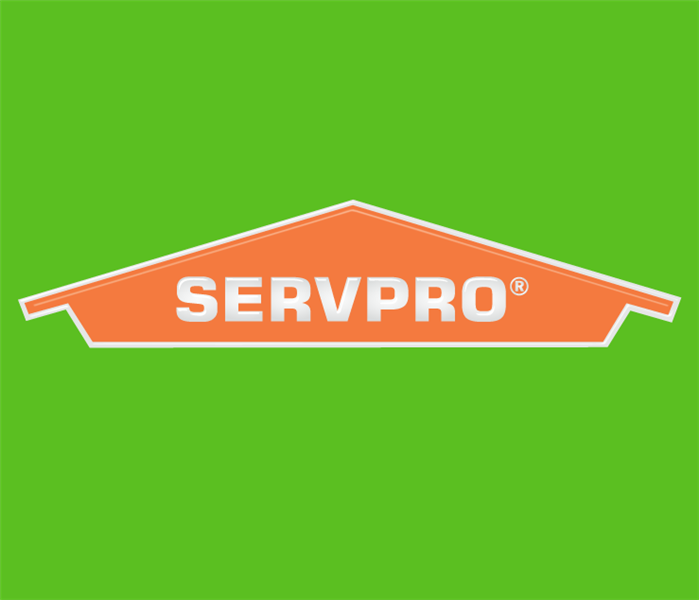 image of the SERVPRO logo
image of the SERVPRO logo
On the list of unwanted home-damaging events, a flooded basement is most certainly at the top. Flooding happens when you least expect it, and is a stressful experience if you don’t know where to turn or who to call. That’s why you should read these helpful tips from your local SERVPRO team…
Stay out of your flooded basement.
Basements flood first because of their low-level, underground nature. Of course your instincts may tell you to start bailing out buckets of water—don’t. The safest thing to do is not enter your basement until you call a professional water restoration company AND an electrician to come and assess the aftermath. Electricity and water are a dangerous combination; you need to keep yourself and your loved ones safe by making sure a professional properly deals with the situation beforehand. Turn off your circuit breaker only if it’s outside of the basement, on the ground level or upper level of your home.
Once it’s safe, remove excess flood water.
Once the electricity is turned off, it may be safe to enter your flooded basement and start bailing out water. Do this as soon as possible to mitigate the damage. Make sure your sump is working properly to help remove the water, or that it’s not malfunctioning and causing flooding in the first place. If flooding isn’t that extensive, use buckets, mops, and towels to soak up the water.
Take photos, then remove and air out damp objects.
Before you start cleaning, take photos of your flooded basement and damaged property for filing your insurance claim. In as little as 48 hours, mold can grow on anything damp in your flooded basement. That’s why after taking photos it’s important to remove any damp objects and leave them in an area to dry out. If you have a finished basement, rip out any wet carpet and padding underneath it. Unfortunately but realistically, your carpet will not be salvageable.
Dry the flooded basement area.
As mentioned earlier, you want to dry the area out to prevent mold growth and further damage. If you don’t own them, rent some fans and a shop vacuum from your local hardware or home improvement store to dry the basement area as quickly as possible. Then have a professional inspect the area make any necessary repair recommendations as well as prevent future mold growth. It may also be wise to buy a dehumidifier to remove excess moisture and allow your basement to dry faster.
When flooding happens, we’ll be there immediately.
May flooding never happen in your home or business. But if it does, know that SERVPRO of Southeast Milwaukee County has the team, tools, and timeliness you need in an emergency. We’re here to serve you 24/7 at 414-421-3500. When it’s less urgent, we’re also here for any cleaning or damage restoration services you need.
Help—My Appliance is Leaking! Take These Immediate Steps
11/17/2020 (Permalink)
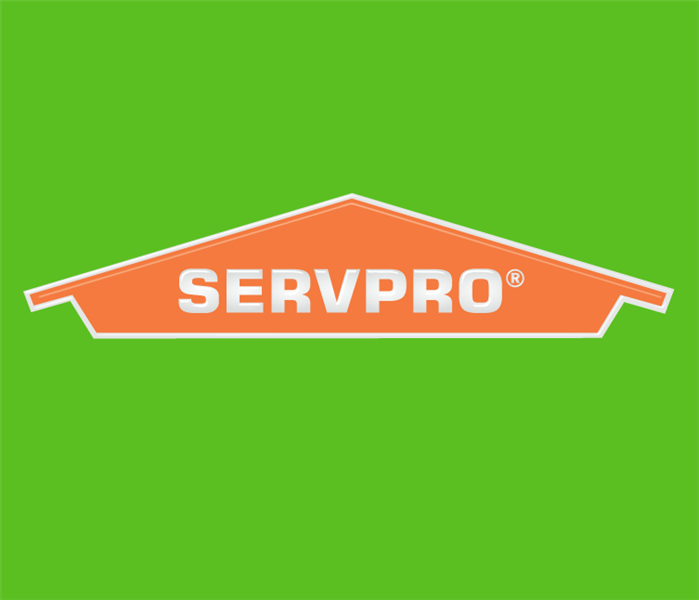 SERVPRO is ready to help with any challenge
SERVPRO is ready to help with any challenge
You wake up, stumble in the kitchen to make your coffee, and see it…Water pooling under your sink. Panic sets in. Few people think about what to do immediately after an appliance is leaking. That’s why the experts at SERVPRO of Southeast Milwaukee County share these steps you can take as soon as you spot the leak.
- Shut off the water source for that appliance.
The sooner you stop the water, the better in terms of damage and repair costs. Most times you’ll find the main water shut-off valves in your basement.
- Determine where the water is coming from.
There are typically three main sources for most water leakage problems: a drain line, a supply line, or a burst pipe. Leaks in drain lines happen when a drain isn’t properly working. Whether a drain leak is fast or slow, it can cause bacteria to grow in the line. A leak in your supply line is coming from that pipe that brings water to your appliance. When you spot a burst pipe, the best thing to do is put a bucket underneath it to catch any leaking water.
- Unplug any electronics near the leaking appliance.
As you know, water and electricity are a dangerous mix. Be sure to shut off and unplug any electronics near the leak. Your safety is paramount: If the leak seems excessive, turn off your home’s circuit breaker, and call your local electrician, as well as the water damage restoration professionals to assess the situation and return your home back to normal.
- Take photos for your home insurance claims.
It’s important to take photos of the leak and the subsequent water damage for insurance purposes, especially if the damage is extensive. Do this before cleaning up any of the mess so that you have accurate documentation of the leak and the property damage.
- Call the professionals to repair the water leak and damage.
You can attempt to identify the water leak type and resolve it yourself, but that may not be the best long-term solution. A wiser investment is to call the local plumbing professional who can fix your leak and appliance properly. If there is damage as a result of the leak, it’s also best to contact your local restoration company, too.
When Leaks Happen, Call SERVPRO 24/7
Don’t deal with the aftermath of water damage from a leaking appliance alone—trust a team of technicians who are equipped to help you around the clock, even on holidays. That team is your trusted neighborhood SERVPRO of Southeast Milwaukee County. Fellow residents and businesses also rely on us beyond water damage restoration—we do everything form air duct cleaning and disinfecting to storm damage and mold remediation. Call 414-421-3500, or contact us online.
What You Can Do About the Damaging Effects of Heavy Rainfall
11/11/2020 (Permalink)
 SERVPRO here to help with water damage
SERVPRO here to help with water damage
Rain, rain, go away…that could never be a more true mantra when heavy rains fall. While water damage is typically associated with situations like flooding or plumbing malfunctions, heavy rain can bring its own set of challenges when it comes to household water damage.
While any moisture level can be damaging, heavy rain is considered rainfall at more than 0.3 inches per hour. This persistent rate can work its way into much smaller vulnerabilities in your home. To help you better prepare and avoid water damage, consider how rapid rainfall rates can cause these issues...
Household Water Damage from Heavy Rains
- Leaky windows and doors. Windows and doors should be sealed against Mother Nature’s elements, but their weatherproofing can age and deteriorate over time. Water can find its way into minuscule cracks and cause damage during a heavy rainfall.
- Inadequate foundation drainage. Heavy rains can build up against the base of your home and cause leaks in your basement or crawl spaces. This can be especially common in homes at the bottom of a hill without adequate drainage around the foundation.
- Vulnerable chimneys and skylights. Chimneys and skylights tend to be more vulnerable to heavy rains. Though they are attractive home features, seals where they meet the roof can weaken over time and be susceptible to leaking when rainfall is heavy.
- Seeping water around the roof. Roof leaks are a leading consequence of heavy rainfall that can sneak up suddenly. Something as minor as a missing shingle or weak spot can let unwanted rainwater seep in.
- Clogged gutters. Gutters clogged with debris can’t properly drain rainwater, which means leaks from puddles as the water is left standing against the roofline. This is why clogged gutters can cause significant home damage after heavy rains.
- Malfunctioning sump pumps. Regular maintenance is critical to homes with sump pump systems. If issues go undetected, the pump system can get overwhelmed and cannot effectively move water away from the home.
Rain + Water Damage = Mold
The unfortunate result of heavy rains is water damage. And the unfortunate result of water damage in homes is a possibility of mold growth. In fact, mold can begin growing in as little as 48 hours after water damage has occurred. That’s why it’s important to stay safe and get excess water cleaned up professionally to minimize the chance of mold growth. Our Team at SERVPRO of Southeast Milwaukee County is ready at a moment’s notice to help with any of your water mitigation emergencies—simply call 414-421-3500.
Count on SERVPRO in Dry Conditions, Too
Rainfall and other causes of water damage aren’t the only threats to your home or business. Thankfully residents and businesses throughout Southeast Milwaukee County rely on our SERVPRO team for everything from air duct cleaning and fire damage restoration to commercial cleaning and home disinfecting. Discover what we can do for you—contact us for a complimentary consultation and estimate today!
My dishwasher leaked all over my hardwood floors
10/31/2017 (Permalink)
 Cupping hardwood floors due to water damage
Cupping hardwood floors due to water damage
It happens. Your dishwasher leaks all over your beautiful hardwood floors and not they are starting to cup. The first thought is that you will need to pull them up and replace them - not necessarily.
Give SERVPRO of Southeast Milwaukee County a call - we have had great success in drawing out the moisture in hardwood floors allowing them to be sanded and refinished Much more economical over replacement.
How do we do this? We use our Injectidry Mat System that uses the power of a high-pressure blower to draw the moisture right through the surface of the floor. We create containment and pump dehumidified air into the containment. It takes between 5-10 days to accomplish dependent on how long the wood was saturated before we began, but the results are amazing.
So, before you start ripping out that beautiful hardwood, give us a call!
SERVPRO of Southeast Milwaukee County "Like it never even happened"
Water Damage
10/27/2017 (Permalink)
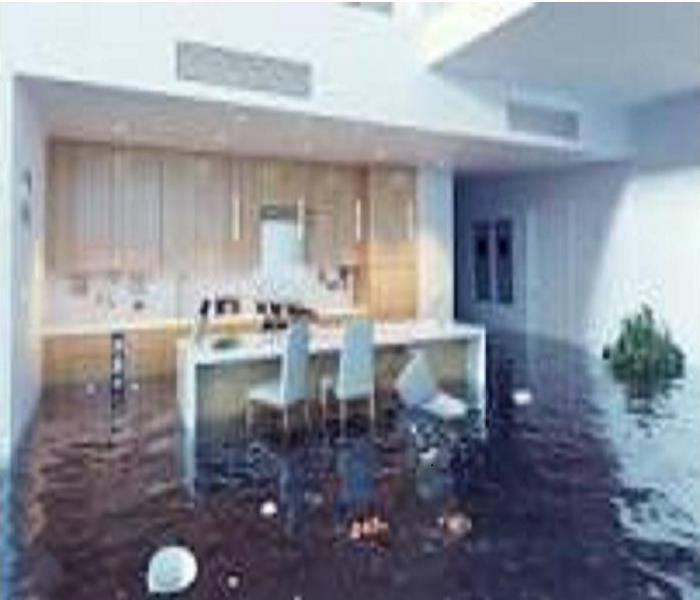 Don't wait, call early
Don't wait, call early
Water damage occurs when excess water begins to pool in ares where it shouldn't. Many different factors can create this excess water and thereby contribute to water damage.
When you are aware of potential causes, you can take precautionary measures to insure against a leak or flood. Basically, the sooner you notice and address your water, the better!
Causes of water damage:
- Bursting or leaking pipes
- Issues with the plumbing system
- Buildup in areas prone to collecting water, such as a crawl spaces, attics and basements
- Faulty or malfunctioning household appliances
- Heating, ventilating and air conditioning issues
- Natural disasters and other weather related water problems.
If you have any water issues, call SERVPRO of Southeast Milwaukee County. We are available 24 hours a day, 7 days a week and can be at your home home or business quickly to take care of the clean up and restoration "Like it never even happened."
A small water leak, may not be small...
9/21/2017 (Permalink)
SERVPRO of Southeast Milwaukee County has crews that are professionally trained to safely clean and restore your home, utilizing the following procedures:
- Identify the Source/Type of Water
- Measure Temperature and Humidity for Drying Analysis.
- Survey the Extent of Damage and Inspect the Premises for Hidden Moisture.
- Perform emergency water extraction.
- Move and block furniture and contents
- Inspect Carpet Pad / Carpet and provide service.
- Apply necessary treatments (disinfectants/deodorization)
- Utilize advanced drying and monitoring equipment.
- Dispose of refuse
Areas that can be affected by a small water leak and you don't even realize it are:
- Break exterior
- Sheathing
- Wall Studs
- Insulation
- Interior area
- Drywall
- Baseboard
- Carpet
- Carpet Padding
- Bottom wall plate
- Sub-floor
- Floor joist
- sill Plate
- Basement
- Foundation
If you notice water, give us a call. SERVPRO of Southeast Milwaukee County will be out to help!
SERVPRO "Like it never even happened."
Home Sweet Home
9/21/2017 (Permalink)
Your home should be your place of rest. But when water begins leaking - even small leaks in areas your can't see - your home could quickly become a source of stress. The possibility of harmful mold, rot and unseen damage may affect the value of your home and the health of loved ones.
SERVPRO of Southeast Milwaukee County understands how disruptive water damages can be for your entire family and will help ensure the water is identified, regardless of where it hides. That's why we offer 24- hour emergency response by our trained, uniformed restoration professionals. With top-of-the line equipment and time-tested cleanup and restoration techniques, SERVPRO of Southeast Milwaukee County has the expertise to help make your house feel like home again.
After all, when it comes to your home and your family, even small disasters can feel like huge problems. So if a water damage occurs in your home, just call us at 414-421-3500. We'll be there to help make it "Like it never even happened"
Peace of Mind
9/21/2017 (Permalink)
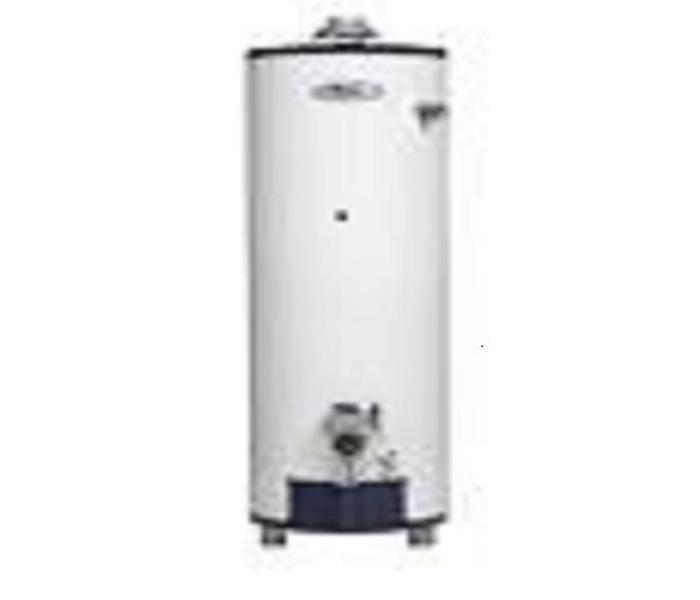 Once every three months, drain one gallon of water from your water heater tank to reduce the sediment collecting in the bottom of the tank.
Once every three months, drain one gallon of water from your water heater tank to reduce the sediment collecting in the bottom of the tank.
Leaks within a home or business can cause extensive damage if unnoticed for a long period of time. Leaking water can seep into flooring, carpets, baseboards and walls while moving throughout the structure. Such a leak not only damages your property, it can also interrupt you day-to-day schedule.
One out of every ten water incidents in a home is caused by a water heater or washing machine. When you find a leak, you can also find the damage it causes to your home.
It's natural to feel a sense of panic. SERVPRO of Southeast Milwaukee County can provide peace of mind. We understand your concerns and are trained in the cleanup and care of your home and property. Our professional technicians utilize the knowledge and experience only gained by doing hundreds of jobs similar to yours and are prepared to properly clean up damage caused by a leaking water heater or washing machine.
SERVPRO of Southeast Milwaukee County is ready to help make it "Like it never even happened"
Should you clean it up yourself?
8/28/2017 (Permalink)
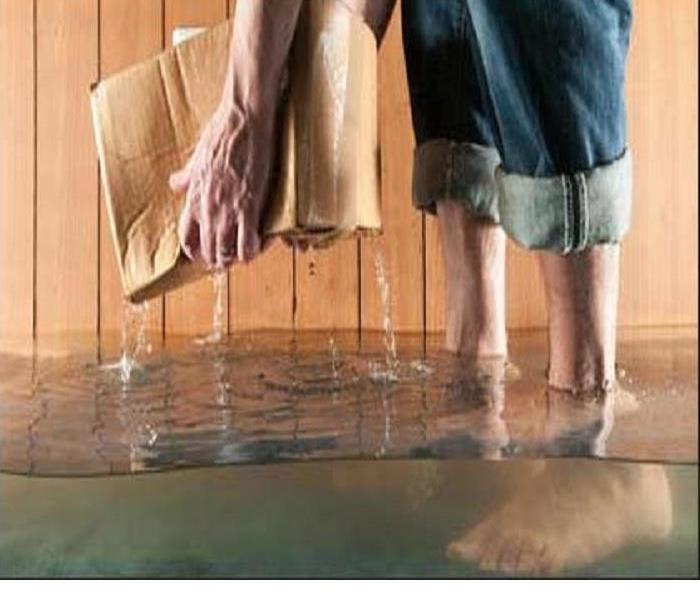 This water could be contaminated.
This water could be contaminated.
There's no such thing as a small disaster. Especially when the water you don't see contains bacteria - or causes mold, rot and other unseen damage. Water damage can affect the value of your property. So before you get out the mop bucket and box fan to try and clean it up yourself, consider how this will affect your property.
A mop and common cleaning products may not be enough for serious water intrusions.
SERVPRO of Southeast Milwaukee County is equipped to safely clean and restore your home or business, utilizing the following procedures:
- Identify the Source/Type of Water
- Measure Temperature and Humidity for drying analysis.
- Survey the extent of damage and inspect the premises.
- Perform emergency water extraction
- Apply necessary treatments i.e. disinfectants/deodorization.
- Utilize drying equipment and monitor drying.
So, before you risk further damaging the value of your home or business by attempting to clean up the mess yourself, call SERVPRO of Southeast Milwaukee County at 414-421-3500.
"Like it never even happened."




 24/7 Emergency Service
24/7 Emergency Service
















